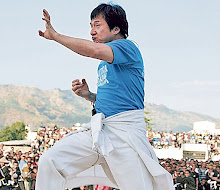
Badminton is a sport played with racquets (rackets) by either two opposing players (known as singles) or two opposing pairs (known as doubles). These opposing players or pairs take positions on opposite halves of a rectangular court. The court is divided by a net. Instead of ball, feathered projectile (known as shuttlecock) is used.
HISTORY OF BADMINTON - The origin of badminton dates back at least two thousand years to the game of battledore and shuttlecock played in ancient Greece, India and China.
- The name, 'Badminton' was derived from Badminton House in Gloucestershire, the home of the Duke of Beaufort, where the sport was played in the last century.
- Gloucestershire, by coincidence, is today the base for the International Badminton Federation (IBF).
- The first badminton club in the world, Bath Badminton Club was established in 1877, which transcribed the rules of badminton for the first time.
- In 1893, the Badminton Association of England published the first proper set of rules, which is similar to that of today.
BADMINTON COURT - The full width of a badminton court is 6.1 metres. However, in singles this is reduced to 5.18 metres.
- The full length of a badminton court is 13.4 metres.
- The service courts are marked by a centre line. It divides the width of the court, by a short service line at a distance of 1.98 metres from the net, and by the outer side and back boundaries.
- The service court is marked by a long service line In doubles, which is 0.78 metres from the back boundary.
- The net is 1.55 metres high at the edges and 1.524 metres high in the centre.
|
|
 BADMINTON TIPS - To win a badminton match, players need to employ a wide variety of strokes in the right situations.
- A common technique in badminton for advanced strokes is slicing. In slicing the shuttle is hit with an angled racket face.
- Slicing underneath the shuttlecock allows to spin the shuttlecock in such a way that it turns over itself several times as it crosses the net.
- A sliced dropshot in badminton allows the player to deceive his opponent about both, power and direction of the stroke.
- Another technique for deception in badminton is double motion. In this technique, the player makes an initial motion towards the shuttlecock and then quickly withdraws the racket to hit the shuttlecock in a different direction.
BADMINTON TIT-BITS - The shuttlecock is strongly affected by wind, hence all the competitive badminton is played indoors.
- In tennis the ball can bounce once before the player hits it whereas in badmintorn the rally ends once the shuttlecock touches the floor.
- Singles game of badminton requires substantially greater aerobic stamina than tennis. It is similar to squash singles, but the squash requires slightly higher aerobic.
- The shuttlecock is very aerodynamically stable. Regardless of initial orientation, the shuttlecock always fly cork-first and remains in the cork-first orientation.
DO YOU KNOW
Smash is the most powerful stroke in badminton | It is a steeply hit downwards into the opponents' midcourt. | The maximum speed of a smashed shuttlecock is always more than any other racket sport projectile. | Fu Haifeng of China has set a record of 332 km/h (206 mph) in men’s doubles on June 3, 2005 in Sudirman Cup. | In singles the record is made by Kenneth Jonassen of Denmark, a speed of 298 km/h (185 mph).
|
|


0 comments:
Post a Comment